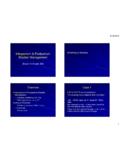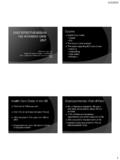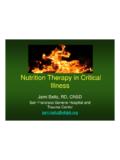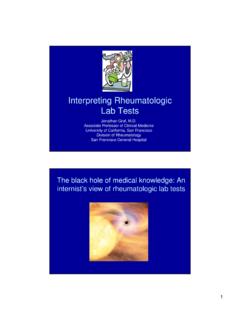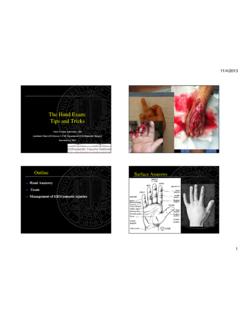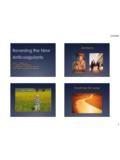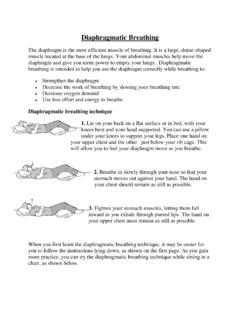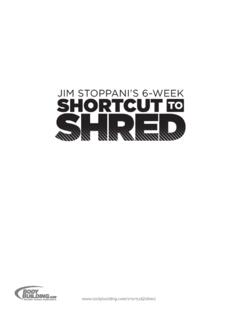Transcription of Knee Pain Handout - UCSF CME
1 Home Exercise Program for: knee pain knee pain can result from a number of different problems. Osteoarthritis, UCSF Medical Center tendinitis, and poor joint mechanics/skeletal malalignments can all cause signifi- Department of Orthopedic cant pain in the knee . If the knee joint is not functioning properly, stress is in- Surgery Sports Medicine Center creased on different structures. Irritation and inflammation will result, causing pain and undue wear and tear on the joint. 1701 Divisadero Street Many factors that cause knee pain can be managed non-surgically.
2 Proper Suite 240. San Francisco, CA 94115 execution of a treatment program is often successful for managing many common knee problems. Treatment focuses on decreasing inflammation and addressing muscle Casey Batten, MD weakness, tightness, or skeletal malalignments, such as flat feet. This is achieved Christina Allen, MD through rest from offending activities, ice and/or anti-inflammatory medications, and a home exercise program to address weaknesses or tightness in the muscles. W. Dilworth Cannon, MD. Arch supports may also help if skeletal malalignments are an issue.
3 Anthony Luke, MD, MPH Rest: C. Benjamin Ma, MD Avoid squatting, prolonged bending of the knee , stairs, and hills whenever possi- ble. If you go to the gym, you should avoid the leg extension machine, deep squats, and lunges. If you have significant pain , cycling or swimming are recom- mended over running or stair-climbing for cardiovascular workouts if possible. Ice/Anti-inflammatories: Ice should be applied following activity for 20-30 minutes. This helps to reduce pain and inflammation. Non-steroidal anti-inflammatory medications such as aspi- rin or ibuprofen are also useful for reducing pain and inflammation.
4 Other pain relievers such as acetaminophen may also be taken. Doses should not exceed that recommended by your doctor. Home Exercises: Stretching: When you stretch a muscle, you should feel tension in that muscle, but not pain . If the stretch is painful, ease off until it is no longer painful. Stretches should be held for _____ and repeated _____. You should stretch at least once a day and if you exercise, you should stretch before the exercise after warming-up and immediately following your exercise session. Hamstrings: When stretching your hamstrings, you should feel tension in the back of you leg.
5 Put your leg up on a table or chair, keep your knee straight, and lean for- ward over your leg. This stretch is shown in Figure 1. Alternatively, you may stretch the hamstrings in a similar manner while sitting on the floor as shown in Figure 2. Figure 2. Figure 1. Calves: Tight hamstrings are often accompanied by tight calf muscles, so it is important to stretch both. When stretching your calves, it is important to keep the knee straight. This will allow you to specifically stretch the calf muscle that crosses the knee joint. To stretch your calf , put the leg to be stretched behind you.
6 Keep the knee straight and the heel on the floor. Lean forward until you feel tension in the back of your lower leg. This stretch is shown in Figure 3. Alternatively, you may stretch your calf by standing with your toes and the ball of your foot on a curb or stair with your heel off the edge. Let your heel fall below your toes until you feel tension in the back of your lower leg. Make sure that your knee stays straight to stretch the longer calf muscle that crosses the knee joint. Figure 3. IT Bands: The IT Band is a muscle/tendon complex that runs down the outside of your thigh.
7 It is commonly tight and if so, can create additional pulling forces on the kneecap. There are several ways to stretch the IT. Band and different individuals find different stretches to be the most effective for them. Find out the best IT Band stretch for you and stick with that one. The first is shown in Figure 4. Lie down on the opposite side from the leg to be stretched. Pull the foot of the painful leg up to your butt. Cross the foot of the non- painful leg over the knee of the painful leg and use it to help pull the painful knee down toward the ground as shown in the Figure 4.
8 Another way to stretch is shown in Figure 5. Sitting up, cross the foot of the leg to be stretched over the knee of the opposite leg. Pull the opposite knee toward you. Additionally, you may push the knee of the tight leg away from you for even more stretch. A third way of stretching the IT. Band is shown in Figure 6. Cross the leg to be stretched behind the other leg. Turn toward the side that is not being stretched and lean down toward the ground. Figure 5 Figure 6. Figure 4. Strengthening: Strengthening exercises focus on correcting any weaknesses that may contribute to knee pain .
9 These exercises will, at first, incorporate little or no knee -bending in order to reduce stress on the joint. Eventually, they will incorporate more movement to gain more strength throughout the range of motion. Quad Sets: Sit on the ground or a table with your painful leg straight out in front of you. Tighten the muscles on top of your thigh as shown in Figure 7. It may feel like your muscles are pushing your knee down into the ground. Hold the contraction for five seconds. Do _____ sets of _____ repetitions. Figure 7. Straight Leg Raises: Sit on the ground or a table with your painful leg straight out in front of you as done for quad sets.
10 After contracting the thigh muscles, lift your leg 12-24 inches in the air as show in Figure 8. Hold the contraction for 5 seconds. Do _____ sets of _____ repetitions. Figure 8. Wall Slides: Position yourself against the wall with your feet about 2 feet away from the wall. Your feet should be shoulder width apart. Slide down the wall until your knees are bent at a 20-30 degree angle. Hold that position for _____ seconds and then straighten back up. Do _____ sets of _____ repetitions. As you progress and the ex- ercise becomes non-painful, you can progress to bending your knees to a 45 degree angle.
